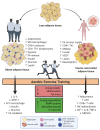Endurance Exercise Mitigates Immunometabolic Adipose Tissue Disturbances in Cancer and Obesity
- PMID: 33371214
- PMCID: PMC7767095
- DOI: 10.3390/ijms21249745
Endurance Exercise Mitigates Immunometabolic Adipose Tissue Disturbances in Cancer and Obesity
Abstract
Adipose tissue is considered an endocrine organ whose complex biology can be explained by the diversity of cell types that compose this tissue. The immune cells found in the stromal portion of adipose tissue play an important role on the modulation of inflammation by adipocytokines secretion. The interactions between metabolic active tissues and immune cells, called immunometabolism, is an important field for discovering new pathways and approaches to treat immunometabolic diseases, such as obesity and cancer. Moreover, physical exercise is widely known as a tool for prevention and adjuvant treatment on metabolic diseases. More specifically, aerobic exercise training is able to increase the energy expenditure, reduce the nutrition overload and modify the profile of adipocytokines and myokines with paracrine and endocrine effects. Therefore, our aim in this review was to cover the effects of aerobic exercise training on the immunometabolism of adipose tissue in obesity and cancer, focusing on the exercise-related modification on adipose tissue or immune cells isolated as well as their interaction.
Keywords: adipocytokines; immune cell; immunometabolism; low grade inflammation; physical activity.
Conflict of interest statement
The authors declare no conflict of interest. The funders had no role in the design of the study; in the collection, analyses, or interpretation of data; in the writing of the manuscript, or in the decision to publish the results.
Figures

Similar articles
-
Parallels in Immunometabolic Adipose Tissue Dysfunction with Ageing and Obesity.Front Immunol. 2018 Feb 9;9:169. doi: 10.3389/fimmu.2018.00169. eCollection 2018. Front Immunol. 2018. PMID: 29479350 Free PMC article. Review.
-
Obesity, inflammation, and vascular disease: the role of the adipose tissue as an endocrine organ.Subcell Biochem. 2007;42:63-91. Subcell Biochem. 2007. PMID: 17612046 Review.
-
T Cells in Adipose Tissue: Critical Players in Immunometabolism.Front Immunol. 2018 Oct 30;9:2509. doi: 10.3389/fimmu.2018.02509. eCollection 2018. Front Immunol. 2018. PMID: 30459770 Free PMC article. Review.
-
The immunomodulating role of exercise in metabolic disease.Trends Immunol. 2014 Jun;35(6):262-9. doi: 10.1016/j.it.2014.02.008. Epub 2014 Mar 26. Trends Immunol. 2014. PMID: 24680647 Review.
-
Adipose Tissue Immunometabolism: Unveiling the Intersection of Metabolic and Immune Regulation.Rev Invest Clin. 2024 Feb 15;76(2):65-79. doi: 10.24875/RIC.23000231. Rev Invest Clin. 2024. PMID: 38718804 Review.
Cited by
-
Novel perspectives on the link between obesity and cancer risk: from mechanisms to clinical implications.Front Med. 2024 Dec;18(6):945-968. doi: 10.1007/s11684-024-1094-2. Epub 2024 Nov 14. Front Med. 2024. PMID: 39542988 Review.
-
Obesity I: Overview and molecular and biochemical mechanisms.Biochem Pharmacol. 2022 May;199:115012. doi: 10.1016/j.bcp.2022.115012. Epub 2022 Apr 5. Biochem Pharmacol. 2022. PMID: 35393120 Free PMC article. Review.
-
Exercise Counteracts the Deleterious Effects of Cancer Cachexia.Cancers (Basel). 2022 May 19;14(10):2512. doi: 10.3390/cancers14102512. Cancers (Basel). 2022. PMID: 35626116 Free PMC article. Review.
-
Hepatic Runx1t1 improves body fat index after endurance exercise in obese mice.Sci Rep. 2023 Nov 8;13(1):19427. doi: 10.1038/s41598-023-46302-w. Sci Rep. 2023. PMID: 37940636 Free PMC article.
-
Neuroinflammation in Alzheimer's Disease.Biomedicines. 2021 May 7;9(5):524. doi: 10.3390/biomedicines9050524. Biomedicines. 2021. PMID: 34067173 Free PMC article. Review.
References
-
- Pond C.M., Mattacks C.A. The effects of noradrenaline and insulin on lipolysis in adipocytes isolated from nine different adipose depots of guinea-pigs. Int. J. Obes. 1991;15:609–618. - PubMed
Publication types
MeSH terms
Grants and funding
LinkOut - more resources
Full Text Sources
Medical

